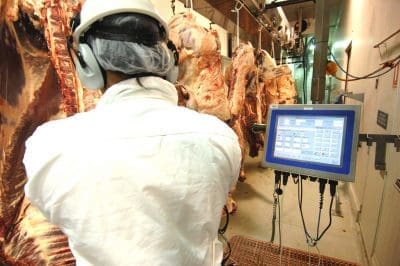THERE’S been a big turnaround in slaughter cattle supply dynamics this week, as cattle country starts to dry out after earlier persistent rain.
Bigger saleyards yardings across eastern Australia early this week have been met with generally lower prices for slaughter types, as a widely-anticipated surplus of cattle starts to emerge. Some yards this morning recorded results as cheap as those seen during the mini-slump before Easter.
 For many Eastern states beef processors, this week’s kill rosters are made up heavily of carry-over cattle delayed due to earlier rain. Some should have died three or four weeks ago, one operator told Beef Central this morning.
For many Eastern states beef processors, this week’s kill rosters are made up heavily of carry-over cattle delayed due to earlier rain. Some should have died three or four weeks ago, one operator told Beef Central this morning.
That’s created some congestion and put some downwards pressure on demand heading towards May, after last week saw some ‘rain money’ splashed around by some operators in an attempt to access cattle during wet conditions, when cancellations and postponements were occurring.
‘Oversupply’ may still be a somewhat premature descriptor term, but things could easily turn ugly if there is a big inflow of slaughter stock over the next four weeks.
Some Queensland processors pushed rates up as much as 20c/kg last week to try to fill some weather-related supply gaps, but that trend now looks short-lived, with grids already retreating.
Most large multi-site, multi-state processors are taking priced bookings through to the end of April, but are offering space bookings only into the early stages of May – indicating some uncertainty about price movements over the next month or six weeks. Already some processors hold ‘quite a few’ space bookings for kills in early-mid May, they said this morning.
Given its size and popularity, Rockhampton’s Beef Expo starting 6 May could provide some supply challenges for plants in the Central and Southern Queensland regions early next month, as large numbers of beef producers take a few days or a week off. ANZAC Day public holiday on Thursday week will also reduce national slaughter capacity by 20pc that week.
Qld Grids back 10-20c
Active offers in southern Queensland this week are mostly back 10-20c/kg on this time last week. Some grids have changed as recently as this morning, with heavy cows quoted this morning at 450-460c/kg and four-tooth grass ox at 520-530c/kg.
Deduct 10c/kg off that for kills in the three Central Queensland plants, and 25c less in North Queensland.
One company said it was tidying up next week’s kills, but offering no-quote space bookings only from weeks starting 29 April and 6 May.
Clearly, rising prices for leaning export trimmings is driving interest in cow slaughter at present, with two smaller Queensland operators heavily supporting northern saleyards cow prices last week – possibly due to earlier cancellations of paddock cattle, but also because of trimmings export orders at increasingly attractive prices.
Further south, processors in eastern regions of South Australia have dropped grids by 20c/kg to 520c/kg on best cows, and 550c on four tooth export bullocks. Southern NSW processor grids are mostly unchanged this week with heavy cows around 460c/kg and four-tooth HGP-free ox 560c.
Saleyards prices under pressure
Most physical sales held this morning and yesterday showed larger offerings, but cheaper prices on cows and heavy steers. Some saleyards prices this week are as cheap as they’ve been seen since the mini-slump seen before Easter.
Wodonga sale this morning yarded 1900 head, with varying price trends. While the usual buyers were present, not all were active or fully engaged. Heavy steers for processors were in limited supply, trading from 270-305c/kg. Bullocks saw steady competition, holding firm at prices ranging from 292-335c/kg. On average, cow prices saw a decrease of 20-30c, with heavy cows selling between 230-254c/kg and middle range and leaner types from 128-212c/kg.
Forbes sale yesterday doubled to 1552 head, with heavy steers and bullocks selling from 265- 333c/kg, while cows slipped 10-15c. Heavy 2 score cows sold from 208-225c and score 3s from 238-252c.
Gunnedah this morning yarded 2500 head, up 20pc on last week. Demand from processors on cows was weaker in the face of large numbers entering the system, with prices 20-25c/kg cheaper while quality had an impact on price change also. The few well finished heavy grown steers to process were much cheaper.
Naracoorte yarded 850 head this morning, with the market showing a cheaper tone over all classes. Heavy grown steers were 20c cheaper, while the lead run of cows averaged around 10c less. There was bigger price declines over heavy heifers and secondary slaughter cattle. The lead run of cows with weight and good fat cover sold from 230-247c, again below the peak of last week when females reached 280c. Plainer cows made185-210c.
A preliminary Roma store sale report showed this morning’s sale offered 9200 head, almost double last week’s catalogue. A small number heavy grown bullocks sold to 284c/kg. Sale still in progress as this item was prepared – full details tomorrow.
Wagga sale yesterday yarded 5800. Competition was inconsistent, leading to a market correction of 20c/kg, with occasional more pronounced declines. In the export market, heavy steers gained 12c, selling from 250-336c, while bullocks lost 10-15c, trading between 255-325c. The cow market struggled as numbers outpaced demand, with caution observed from both processors and restockers during bidding. Heavy cows sold 21c cheaper, ranging from 215-258c, while leaner types fetched from 190-227c.
Clermont sale this morning yarded around 1400, with cow prices noticeably cheaper, and well below direct grid equivalence.



HAVE YOUR SAY